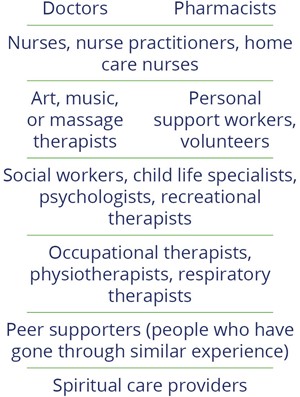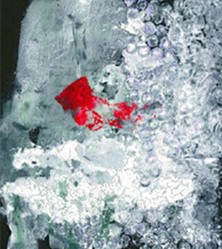Palliative care explained
“My child lived with a life-limiting illness and we were able to access palliative support for 5 years before his actual death. So palliative care was not just at the end of life but was a huge factor in quality of life and being able to extend very joyful events and help with the pain management and support the quality of living. In palliative care, it’s not just about end of life. For us, it was very much about the quality of life. And then that carried through to his quality of death as well” - Kim, mother of Kevin

Palliative care is an approach to healthcare that focuses on providing comfort and improving the quality of life of a person with a serious illness. Palliative care may be offered at any point after the diagnosis to help the patient and support the family. It can be integrated with the standard care used to treat the illness. Sometimes, palliative care is the main focus of care.
According to the World Health Organization (WHO, 1998a) palliative care for children includes, “care of the child’s body, mind and spirit,” and also includes support for their family members. Palliative care addresses:
- A child’s physical symptoms like pain, nausea, dizziness, loss of appetite, confusion
- A child and family members’ worries and questions
- A child and family members’ feelings including grief and anxiety
- A child and family members’ spiritual and cultural needs and wishes
“My child lived with a life-limiting illness and we were able to access palliative support for 5 years before his actual death. So palliative care was not just at the end of life but was a huge factor in quality of life and being able to extend very joyful events and help with the pain management and support the quality of living. In palliative care, it’s not just about end of life. For us, it was very much about the quality of life. And then that carried through to his quality of death as well.” – Kim, mother of Kevin
When your child is diagnosed with a serious illness, the main focus is usually on treating the medical condition. However, evidence shows that palliative care should be provided together with active treatment when someone has a serious disease. Palliative care can be provided to help manage pain and symptoms and to help your child have the best possible quality of life, from the time of diagnosis right up until the end of life. Palliative care may continue after a child dies, to provide support to the family.
Palliative care is not the same as end-of-life care. Palliative care can help at any time from diagnosis to death, and even after someone dies, when a family is grieving. When a person is dying, it is common to focus care on things that improve comfort and quality of life, which is why palliative care may take on a central role at this time. But lots of patients and families benefit from palliative care well before end of life.
A palliative approach to care helps children with a wide variety of medical conditions. Children may be diagnosed with:
- Cancer
- Genetic conditions, metabolic or neurological disorders
- Heart, lung, kidney or liver diseases
- Prematurity or a condition diagnosed before birth
- Rare disease
- Awaiting a transplant (example: bone marrow or solid organ)
- Unclear diagnosis
These conditions can cause very different symptoms, and require different treatments or therapies. Some children may be diagnosed and expected to live a very short time, while others may live with their diagnosis for many years. Palliative care can help children of all ages from premature newborns to young adults.
Palliative care can be provided in different ways, by different people, depending on where you live and where most of your child’s care is being provided. Palliative care can happen at the same time that other health care teams are working to treat the illness or prolong your child’s life. This may mean that your child’s primary health care team provides palliative care, or if a special palliative care team is available, they may work together with your family and your child’s primary care team. In these situations, two or more health care teams may work together as one larger team. It is not uncommon for clinicians in your own community to provide palliative care as well.
Your child might receive palliative care from one or more of these groups:
- Primary health care team (like oncology, cardiology, or others)
- Specialist pediatric palliative team
- Community healthcare providers
A pediatric palliative care team includes specially trained healthcare providers who support your child’s physical, emotional, and spiritual health in order to provide the best quality of life possible. They also offer support to the whole family. This team may include:

Palliative care can be provided anywhere. The places where care is provided often change, depending on the physical and emotional needs of the child and family and on where the child and family feel most comfortable at different times during the illness. The setting can change from one place to another, as your child’s needs change. The most common settings are:
- Hospitals
- Hospices
- Home
- Other community settings
Hospitals
In hospital, your child might receive palliative care from their main healthcare team or from a palliative care provider or a palliative care team. The palliative care team will work with your child’s primary care team or may be the team that is most responsible for your child’s care.
If your child is not staying in the hospital, you can meet with members of the palliative care team when you come to the hospital for appointments with your other healthcare providers.
Hospices
Hospices offer full-time medical and nursing care, in a place that feels more like a home environment than a hospital. There are some specialized pediatric hospices just for children and some that serve both adults and children.
Some hospices offer other services to children receiving palliative care. The types of care include:
- Respite care - hospice staff care for your child while you and your family rest or do other things
- Pain and symptom management - children are admitted to evaluate symptoms and to find effective treatments
- Transitional care - support to prepare you and your child to move back home after being in hospital
- End-of-life care - support to dying children and their families
- Community care - in-home volunteer support to families
Not every province has a pediatric hospice. They are located in cities and provide services to families in large geographic areas. To find out where pediatric hospices are located, refer to the link below.
Home
Children receiving palliative care may be cared for in their own home. The health care providers who come into the home may vary depending on where you live. These community providers usually work closely with members of your child’s pediatric hospital team to make sure your child receives the best care. Your healthcare team will help you arrange the care you need. Your child may receive care from:
- Members of a specialist palliative care team
- Family doctor, pediatrician, nurse practitioner
- Nurses
- Personal support workers
- Volunteers
- Peer supporters
Resources
- Programs and Services - Canadian Virtual Hospice, click on your province and choose:
-
- Programs, services and hospice for children
- Programs and services for adolescents and young adults
Pediatric palliative care experts can be found in nearly every Children’s Hospital across Canada.
Resources
- Programs and Services - Canadian Virtual Hospice, click on your province and choose:
-
- Programs, services and hospice for children
- Programs and services for adolescents and young adults












